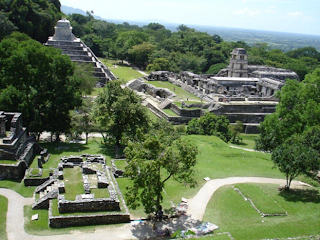Religion
Religion was an integral part of Mayan life. The civilization was a theocracy, and both religion and the government were controlled by one leader.
The Mayan religion was a polytheistic faith comprised of approximately 150 gods and goddesses. Each deity was associated with a part of the natural world - such as the sky, wind and corn – and they were held responsible for all aspects of Mayan daily life. Mayan gods were demanding and unpredictable, and the Mayans relied on priests to interpret their will. It was believed that only the priests had the power to receive and interpret the word of the gods. The priests used divination and prophecy to distinguish lucky days from unlucky days. This practice relied on their calendar system and knowledge of astronomy, and sometimes involved the ingestion of hallucinogenic herbs. The priests used their findings to advise the rulers on such matters as agriculture and waging war.
The priests in the Mayan civilization were part of the ruling elite. Priesthood was hereditary, and priests were succeeded by their eldest son or closest male relative. Mayan priests also practiced medicine, blessed the dead or dying, and educated candidates for priesthood. Candidates learned astronomy, mathematics, hieroglyphics, calendrics, and the proper method for performing many rituals.
The Mayans believed that their existence depended on the goodwill of their gods. Priests performed various religious rituals, sacrifices and ceremonies in an effort to please and honour the gods. The most important of these religious events were those held in honour of the harvest gods. The performance of the correct ritual, ceremony, or sacrifice at the appropriate time was essential. The Mayan religion was brutal; virtually all of the rituals involved blood and sacrifice, because human blood was thought to be essential to sustain the gods. Some rituals required bloodletting, a practice that was considered an honour and was usually reserved for the nobility, and other rituals called for sacrifices. Kings often led slave-raids to supply their priests with candidates, though orphaned children and criminals were other candidates. It was thought that the sacrificial victims would receive great rewards in the afterlife.
The Mayan Gods
The principle deities of the Mayan religion were Hunab Ku, Itzamna, Ixchel, Kinich Ahau, Hun Hunahpu, and Chac.
Hunab Ku was the supreme Mayan deity, the head of the Mayan pantheon. The Mayans believed he rebuilt the earth after a series of disasters. He was an impersonal deity who did not often interact with the people, which was uncommon in the Mayan faith. Little else is known about the god.
Itzamna, which means “Lizard House,” was possibly Hunab Ku’s son. Residing in the heavens, he was the supreme being of earth and sky. The Mayans believed the god also introduced their calendar and system of writing to the priests. Itzamna ruled the thirteen layers of heaven, though each individual level was ruled by a lesser god.
Ixchel was Itzamna’s consort, despite the fact that she was married to another god. Ixchel was seen as the “Mother of all Gods” and the greatest of all the goddesses. She was the goddess of the moon, healing and pregnancy, as well as the matron of weaving (an art form she invented), and the protector of woman and children.
Kinich Ahau, or “Sun-faced Lord,” was the god of the sun. Often appearing in the shape of a firebird, Kinich Ahau was an important deity – he provided the light and heat essential for human life. Kinich Ahau was said to be young when he woke at dawn, but by the end of his journey to the western horizon, was thought to be old and bearded.
Hun Hunahpu was a god of fertility (“bringer of growth”) and the maize god; he is arguably the most important Mayan deity, as he presided over the Mayan’s most essential crop. He is the father of the Mayan hero twins Xbalanque and Hunahpu. According to Mayan legend, he was beheaded and killed in the underworld, but was reborn with his son’s help. He is depicted as a young man, sometimes with maize growing from his head.
Chac, the Mayan god of rain, thunder and lightning, is portrayed in Mayan art painted blue, with hair tied on top of his head and a long nose. Still worshipped by Mayans today, Chac serves a dual role; though he can be a benefactor, bringing good weather and life, he can also be destructive, bringing famine, floods or violent storms. Mayans made offerings to Chac at the Sacred Cenote at Chichen Itza to ensure his goodwill.
Death in the Mayan Religion
Death was feared in the Mayan tradition. The Mayan afterlife was divided into thirteen levels of heaven (ruled by thirteen individual gods, and in general by Itzamna) and nine layers of hell, arranged beneath the earth. A place of fear and dread, this underworld was ruled by evil gods, like the Xibalban lords of death and the Jaguar God of Night. The few individuals in the deities’ favour would continue their afterlife in one of the levels of heaven, while others would be trapped in the depths of hell. A priest was called when a person was on their deathbed to bless them and perform an exorcism to drive away any evil spirits. After death, common people in the Mayan empire were buried under the floor of their houses with food and tools. The nobility, on the other hand, were given elaborate burials by their families; they were laid to rest in intricately adorned beautiful temples or underground vaults, which were then filled with valuable commodities.
Royal tomb at Palenque














